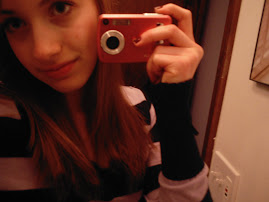Saturday, February 16, 2008
Girl In Hyacinth Blue: Summary 1
When I read the first 48 pages of Girl In Hyacinth Blue by Susan Vreeland, it got me really excited to read the next part of the novel. Susan Vreeland is very good at writing because she has a way of wanting you to keep reading more. So far, the story is about a very sure-of-himself math teacher named Cornelius Engelbrecht. He owns a painting passed down from his father, which he swears is Vermeer: "A most extraordinary painting in which a young girl wearing a short blue smock over a rust-colored skirt sat in a profile at a table by an open window." (pg 4). The whole story of the painting started when Engelbrecht and other teachers that he worked with, including Richard, were talking after a funeral for Dean Merrill. They were conversing about what people's last words were before they died. That is when Cornelius said that his father's last words were "An eye like a blue pearl." Richard was confused with what that meant and so Cornelius, knowing that Richard was an art teacher, invited Richard over his house to show him what it meant. When they both got to Cornelius's house, he showed Richard the painting of the girl. Richard is blown away with how beautiful it is, but doesn't believe that it is a real Vermeer. Even though Cornelius tells him all the similarities between Vermeer's other paintings, like same tile work, same strokes of paint, etc., Richard is still stubborn to the fact that this is a real Vermeer. He thinks: How can Cornelius get a real Vermeer painting? Once Richard leaves, Engelbrecht thinks about how he really got the painting: His father, Otto Engelbrecht, saw the painting back when they lived in Germany, along with other valuables such as a silver teaset, and thought that it was beautiful. When he had to move his family to America because they were Jewish, he went back and stole the painting. The only people who knew about this where Otto and his son, Cornelius. When Otto died, he left Cornelius "a painting of a young girl sewing at a window." (pg 23). When Cornelius thinks about this, he starts to feel guilty that his father had stolen this wonderful masterpiece. He considers burning the painting, (he even starts a fire,) and starts to think that maybe this really isn't a Vermeer, and in that case, it wouldn't matter if he burned it. But if it is, then he is destroying a painting meant for the whole world to see. He finally decides not to burn it, but promises himself that he will someday. The next time when Cornelius sees Richard, Richard asks if he could see the painting again. When Richard sees the painting in daylight, he sees it in a different view and starts to wonder if it really is a Vermeer. The next scene takes place back in the 1940s, where there is a Jewish family is getting ready for passover. There is a daughter named Hannah and her dad and her went to an auction. At the auction, Hannah saw the same painting of the girl looking out the window and wanted her dad to buy it. When her dad won the bid, Hannah got exicted over one of the only things she ever got excited about. Her family thought that she was a boring kid who didn't like anything, but she really liked that painting. You can tell that that is the same painting as before in the book because it tells about the same silver teapot. That is where I left off in the story. I predict that later on in the novel, when Cornelius dies, he is going to pass it down to Richard and Richard is going to tell the world about it. I like this book so far and i cannot wait to read more of it.
Subscribe to:
Post Comments (Atom)


1 comment:
Wow! How's that for a plot summary? Hmm... Ok, I'm glad you're off to a strong start (you can keep going if you want and blog the rest of these now); however, there needs to be more of YOU in this blog. I want you to interact with the story, not just remember it. Question: Do you type after you read a few pages, or remember it when you're done?
18/20 (A-) Get more interaction with the text into your next blog.
- MB
Post a Comment